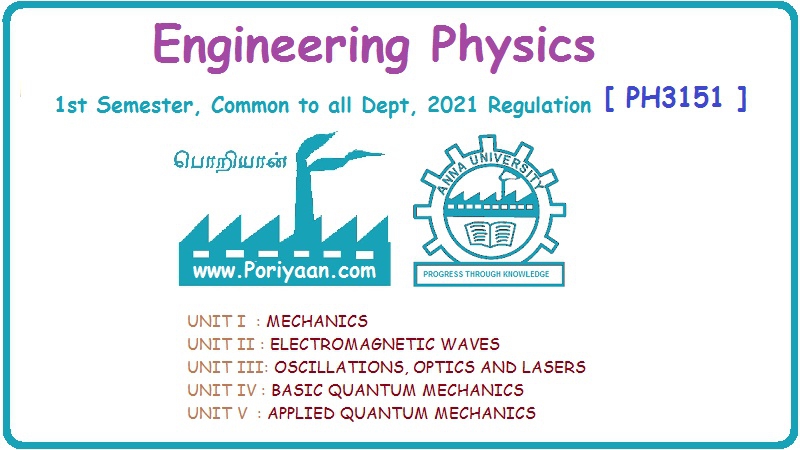Engineering Physics: Unit III: b. Optics
Two Marks Questions with Answers
Optics | Engineering Physics
‘2’ Marks Question with Answers: Engineering Physics: Optics
Part - A ‘2’ Marks Question with Answers 1. State laws of reflection. (i) Incident ray, normal and reflected ray lie in the same plane. (ii) The angle of incidence is equal to the angle of reflection i.e. ∠ i = ∠ r 2. State laws of refraction. (i) The incident ray, the refracted ray and the normal at a point of separation of two media lie in the same plane. (ii) For any two medium, the ratio of sine of angle of incidence to sine of angle of refraction is constant. It is known as Snell's law. Therefore, sin i / sin r = constant 3. Define refractive index of the medium. The ratio of velocity of light in vacuum to velocity of light in medium, is called as refractive index. 4. What is total internal reflection? When a ray of light within a denser medium (e.g. water) approaches the surface at an angle of incidence greater than the critical angle, the ray of light is reflected back into the same medium (i.e. water). This phenomenon is known as total internal reflection. 5. Define critical angle. The angle of incident at which the refracted ray just graze surface between denser and rarer media is called critical angle. 6. Give conditions of total internal reflection. (a) The light should be incident from denser medium to rarer medium. (b) The angle of incidence i in denser medium should be greater than critical angle θc. 7. Write expression for critical angle. n1 - refractive index of denser medium n2 - refractive index of rarer medium 8. Mention a few applications of total internal reflection. (i) Mirage. During the day time in the desert, it is seen that sand at some distance from the observer looks like a pond of water. This illusion is called mirage and it is caused due to total internal reflection of light. (Fig 4.6) (ii) Optical fibre. An optical fibre is a transparent fibre used to conduct light through the phenomenon of total internal reflection. 9. What is interference? This modification or change of intensity of light resulting from the superposition of two or more waves of light is called interference. 10. What is airwedge? A wedge shaped (V-shaped) air film enclosed in between two glass plates is called air wedge. 11. What is the expression for the fringe width in air wedge experiment? λ - wavelenth of the light source θ - Angle of wedge 12. What is the expression for the thickness of the wire in airwedge experiment? λ - wavelenth of the light source l - Distance from the edge of contact β - Fringe width 13. What is Michelson interferometer? An interferometer is an instrument for measuring small changes in length. It is based on the principle of interference. Michelson originally designed an interferometer which is used to find the wavelength of monochromatic light source and thickness of thin strips. 14. What are the applications of Michelson interferometer? It is used to find (i) the wavelength of a given light source. (ii) the refractive index and thickness of a transparent material (iii) the resolution of wavelengths (iv) the standardisation of metre



Engineering Physics: Unit III: b. Optics : Tag: : Optics | Engineering Physics - Two Marks Questions with Answers
Related Topics
Related Subjects
Engineering Physics
PH3151 1st semester | 2021 Regulation | 1st Semester Common to all Dept 2021 Regulation
